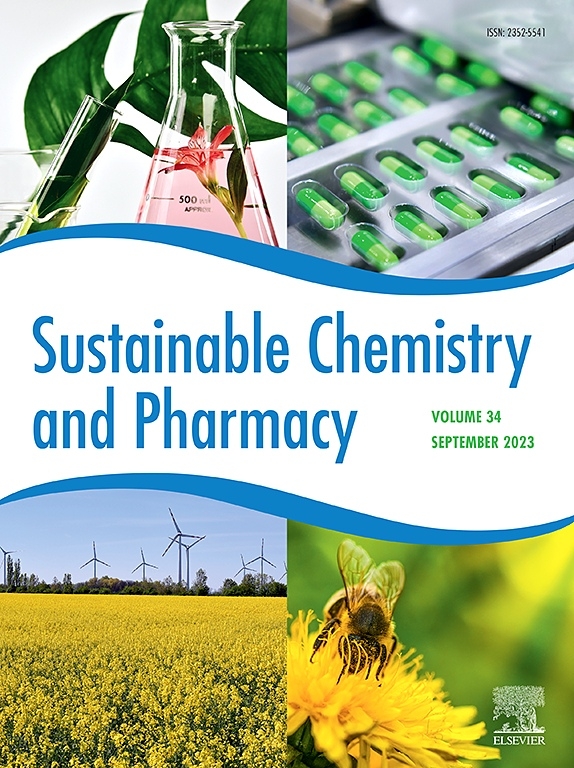治疗性深共晶系统对结直肠癌选择性毒性的分子景观
IF 5.5
2区 化学
Q2 CHEMISTRY, MULTIDISCIPLINARY
引用次数: 0
摘要
最重要的现代医学挑战,如癌症的高死亡率,强调了对改进治疗药物的日益增长的需求。由于共晶系统具有卓越的物理化学和生物特性,我们关注它们,同时主要符合绿色化学原则和联合国可持续发展目标(SDG)的可持续性指标,我们旨在推动人们对它们作为抗癌剂的理解。考虑到治疗性深共晶系统(THEDES)对结直肠癌(CRC)细胞的抗癌活性有希望的报道,我们试图填补这些共晶对这些癌细胞分子景观影响的知识空白。为此,采用综合方法研究了萜烯-薄荷醇(Me),百里香酚(Thy),紫苏醇(POH)和柠檬烯(Lim) -与布洛芬(Ibu)作为THEDES结合对通透性,细胞运输,细胞活力,活性氧(ROS),细胞代谢组和全身毒性的影响。暴露于THEDES导致Ibu细胞摄取增加,ROS消耗减少,并通过凋亡诱导细胞死亡。此外,结直肠癌细胞的代谢物景观发生了改变,对必需的代谢途径(如脂质和厌氧糖酵解能量产生途径)产生了有害影响。此外,在测试的浓度范围内,观察到这些THEDES的非相关全身毒性。这些发现强调了THEDES作为选择性抗癌药物的潜力,同时为开发符合可持续性指标的治疗方法提供了一条有希望的途径。本文章由计算机程序翻译,如有差异,请以英文原文为准。

Molecular landscape of therapeutic deep eutectic systems selective toxicity towards colorectal cancer
The foremost modern medicine challenges, such as cancer's high mortality rates, have emphasized the growing need for improved therapeutic agents. Following eutectic systems spotlight due to their remarkable physicochemical and biological properties, while mostly in compliance with the Green Chemistry Principles and sustainability metrics as the Sustainable Development Goals (SDG) from United Nations, we aimed to push forward their understanding as anticancer agents. Considering therapeutic deep eutectic systems (THEDES) promising reports of anticancer activity towards colorectal cancer (CRC) cells, we sought to fill the knowledge gap on these eutectics impact on these cancer cells molecular landscape. For that, an integrated approach was used to study how combining a terpene – as menthol (Me), thymol (Thy), perillyl alcohol (POH) and limonene (Lim) – with ibuprofen (Ibu) as a THEDES, affects permeability, cellular transport, cell viability, reactive oxygen species (ROS), cell metabolome and systemic toxicity. THEDES exposure resulted in increased Ibu cellular uptake, depletion of ROS, and cell dead induction via apoptosis. Moreover, CRC cells experienced alterations in their metabolite landscape with deleterious effects on essential metabolic pathways, such as lipid and anaerobic glycolysis energy production pathways. Furthermore, non-relevant systemic toxicity of these THEDES, within the range of concentrations tested, was observed. These findings underscore THEDES potential as selective anticancer agents, while offering a promising path for the development of therapeutics aligned with the sustainability metrics.
求助全文
通过发布文献求助,成功后即可免费获取论文全文。
去求助
来源期刊

Sustainable Chemistry and Pharmacy
Environmental Science-Pollution
CiteScore
8.20
自引率
6.70%
发文量
274
审稿时长
37 days
期刊介绍:
Sustainable Chemistry and Pharmacy publishes research that is related to chemistry, pharmacy and sustainability science in a forward oriented manner. It provides a unique forum for the publication of innovative research on the intersection and overlap of chemistry and pharmacy on the one hand and sustainability on the other hand. This includes contributions related to increasing sustainability of chemistry and pharmaceutical science and industries itself as well as their products in relation to the contribution of these to sustainability itself. As an interdisciplinary and transdisciplinary journal it addresses all sustainability related issues along the life cycle of chemical and pharmaceutical products form resource related topics until the end of life of products. This includes not only natural science based approaches and issues but also from humanities, social science and economics as far as they are dealing with sustainability related to chemistry and pharmacy. Sustainable Chemistry and Pharmacy aims at bridging between disciplines as well as developing and developed countries.
 求助内容:
求助内容: 应助结果提醒方式:
应助结果提醒方式:


